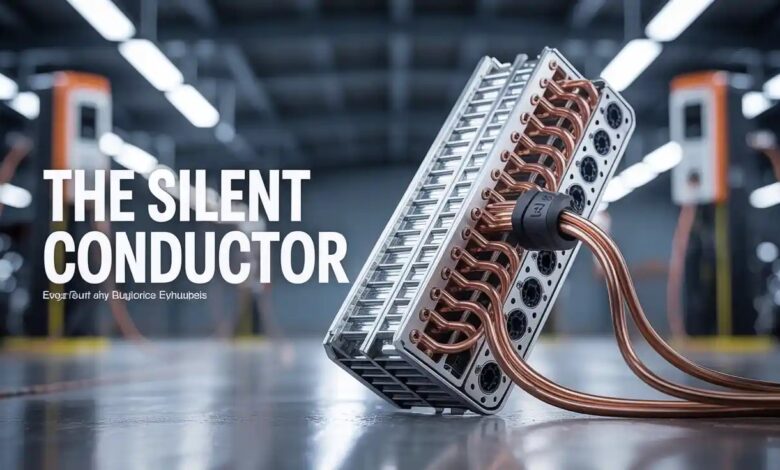The Silent Conductor: Why Busbars Are Powering the EV Revolution from Behind the Scenes

In 2025, the world may remember sleek EV designs, fast-charging stations, and bold government EV policies. But few will remember the small, flat, unassuming component hidden under the hood—the busbar. Yet without it, none of the EVs hitting the roads would even move an inch.
Did you know? According to Stratview Research, the global EV busbar market is projected to cross US$ 4.8 billion by 2030, growing at a CAGR of over 15% during 2024–2030. Why? Because busbars—those compact, laminated conductors—are quietly becoming indispensable in managing the complex flow of high-voltage electricity in modern electric vehicles.
Problem: Power Is Getting Smarter—but Also More Complicated
Today’s EVs are no longer simple battery-powered cars. They’re mobile power grids packed with battery management systems, high-voltage inverters, electric motors, on-board chargers, and energy recovery systems. As EV architectures evolve toward 800V platforms and beyond, the electrical complexity under the hood is increasing exponentially.
This complexity creates new challenges:
- Higher power demands in smaller spaces
- Increased heat generation due to high current flow
- Greater electromagnetic interference (EMI) from multiple electronic components
- The need for higher energy efficiency and faster charging
- Weight and space constraints within EV platforms
The traditional wire harness system that worked for internal combustion engine (ICE) vehicles simply can’t keep up. Enter: busbars.
Agitation: The Hidden Risk of Overlooking a Critical Component
While OEMs obsess over battery chemistries, range efficiency, and powertrain integration, poor current transmission design could sabotage the entire system.
Improper or outdated conductor systems can lead to:
- Power losses, reducing energy efficiency
- Heat buildup, leading to battery degradation or even safety hazards
- Bulky wiring systems, compromising design flexibility and interior space
- Slower charging times, impacting user experience
For EV makers trying to differentiate on performance, safety, and cost—all while meeting net-zero targets—ignoring the busbar’s role is a dangerous oversight.
Solution: How Busbars Are Quietly Reshaping the EV Landscape
Busbars are flat metallic strips (typically made from copper or aluminum) that conduct electricity within the battery pack and across EV power electronics. Unlike conventional cables, they:
- Offer better current-carrying capacity
- Enable compact, layered packaging
- Reduce resistance and energy loss
- Improve thermal management
- Lower the weight of the electrical system
This makes them ideal for use in:
- Battery packs (interconnecting cells and modules)
- Inverters and converters
- Charging ports
- Electric motors and drivetrains
What’s Driving Market Growth?
Stratview Research identifies several key growth drivers for the EV busbar market:
- Surging EV Sales: Global EV sales surpassed 14 million units in 2023 and are expected to double by 2030.
- 800V Architectures on the Rise: Premium and commercial EVs are moving beyond 400V platforms, demanding advanced busbars to handle higher voltages and power densities.
- Focus on Weight Reduction: Lightweight aluminum busbars are increasingly being used in place of copper to reduce EV curb weight.
- Battery Standardization and Modularity: As battery packs become more modular, laminated busbars offer an ideal solution for scalable, repeatable interconnections.
Innovation in Materials and Design: Who’s Leading the Charge?
The busbar landscape is evolving with material innovation and advanced manufacturing:
- Copper remains dominant, especially for high-current applications. However, aluminum busbars are gaining traction due to weight and cost benefits.
- Flexible and laminated busbars with insulation layers are being used for space-constrained designs.
- Integration with sensors (for voltage, temperature, and current) is enabling smarter power electronics.
- Additive manufacturing and laser welding are improving production scalability and reliability.
Tier-1 suppliers and OEMs are collaborating with busbar manufacturers to co-design solutions early in the EV development cycle.
What Forward-Thinking Companies Are Doing
- Tesla and Porsche use custom-designed laminated aluminum busbars for high-speed energy transfer and weight optimization.
- BYD and CATL are innovating with multi-layer busbar structures for compact battery module assembly.
- Startups in the commercial EV space are partnering with busbar suppliers to handle high current needs in electric trucks and buses.
Global players like Mersen, Methode Electronics, Rogers Corporation, and Amphenol are investing in R&D and expanding production lines to cater to EV-specific needs.
Strategic Takeaways: Why Busbars Deserve Boardroom Attention
- Busbars are not just a component—they are a strategic enabler for next-gen EV architectures.
- As vehicle power demands increase, early integration of busbar design into platform engineering can unlock performance, efficiency, and cost advantages.
- OEMs and Tier-1s that invest in modular, lightweight, and smart busbar systems will gain a critical edge in EV performance, safety, and cost optimization.
- According to Stratview Research, the busbar demand per EV is expected to increase by 1.7x by 2030, with battery interconnects and high-voltage power modules driving the largest share.

